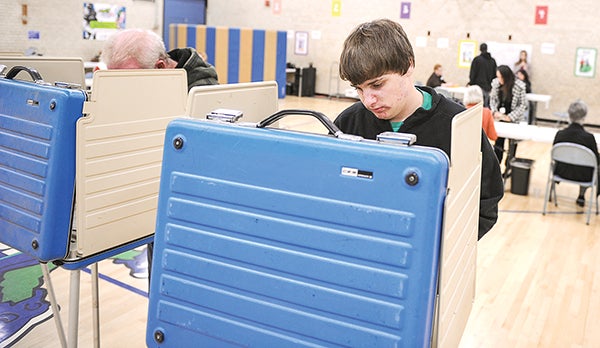Turnout decreases from 2008
Published 10:47 am Thursday, November 8, 2012

Spencer Holtorf walks up to a booth to vote Tuesday afternoon at Southgate Elementary. Turnout decreased slightly in Mower County compared to 2008. -- Eric Johnson/photodesk@austindailyherald.com
Auditor-treasurer says local numbers down slightly
Once again, Mower County polling locations had slightly fewer voters during a presidential election, and the fewest voters since 2000.
The Minnesota Secretary of State recorded 18,675 voters, including absentees and early registrants in Mower County. In 2008, 19,302 people voted, compared to 20,357 in 2004. In 2000, Mower produced just 75 fewer voters than this year.
While there is a lot of talk about voter fatigue, Mower County Auditor-Treasurer Doug Groh blames the declining trend on aging demographics in Mower County. Groh believes voter interest is still high and was especially so this year because of the two proposed amendments to the Minnesota Constitution.
“I think there is continued voter interest,” Groh said.
In fact, Minnesota had a record turnout of voters, as 2.94 million residents voted on Tuesday. That number is up from 2.91 million in 2008, according to the Minnesota Secretary of State.
Groh added some people choose not to vote as it can be difficult to choose a particular candidate. However, on yes-or-no issues, most people take a stance and will vote.
Though Minnesotan’s voted “no” on a proposed marriage amendment to define marriage between one man and one woman, Groh isn’t surprised Mower County voters leaned toward “yes.” He said more rural counties with older demographics have differing views. More populous counties, he said, tend to have younger voters who have filtered into today’s changing views.
Regarding voter ID, Groh also isn’t too surprised Mower County voted “no” on imposing a new amendment. While Groh believes there are some positives to tightenign voter restrictions, he said he opposes any such idea as a constitutional amendment.
Because Minnesota’s population is growing, the percentage of people voting actually dropped to about 77 percent from 78 percent in 2008, Ritchie said. Minnesota’s highest general-election turnout came in 1956, when about 83 percent of eligible voters participated.
Ritchie said he expects “a more serious conversation” in the Minnesota Legislature in 2013 about moving Minnesota farther toward mail-in and early voting. Nationally, nearly 40 percent of all ballots were cast well before Election Day.
In Minnesota, only about 9 percent of voters cast so-called absentee ballots, which are promoted as an option only for voters who are traveling. Ritchie said encouraging early ballots may be a good way to keep Minnesota at the top of the voter turnout list, especially among young people and others who don’t have a personal “tradition” of voting yet.
“We’re clearly out of the mainstream when it comes to early voting,” Ritchie said. “You’d get much faster returns, and likely even higher participation, if we had true early voting. But it’s been a conversation that the Minnesota Legislature, for whatever reasons, hasn’t really had yet.”
Ritchie said Minnesota might have been expected to have a lower turnout this year than in 2008 because it was mostly ignored by the presidential candidates, not being considered a swing state, and because it lacked a competitive U.S. Senate race. But he said the constitutional amendments might have been a catalyst for continued high turnout to close the gap.
The amendments appear to have brought out young voters much the way former wrestler Jesse Ventura did in 1998 when he unexpectedly won the governor’s race, Ritchie noted, and in 2008 when President Obama drew huge numbers of first-time voters to the polls.
“It will be interesting to see if that (opposition to the marriage amendment) is what energized voters, especially young voters,” he said. “That would seem to be one explanation. … But we also had all members of the Legislature up, and a lot of school bond referendums on ballots, and lots of municipal races. All of those contribute to bringing people out in some way.”
—The Associate Press contributed to this report.

